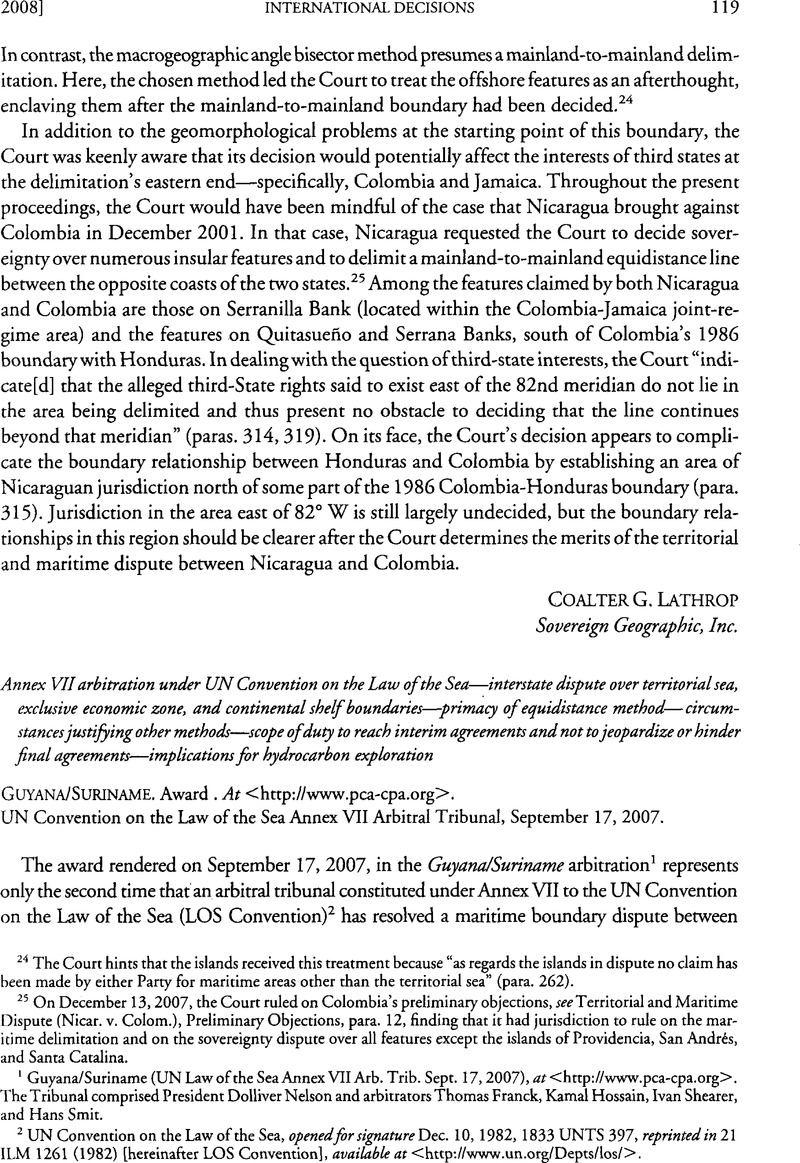Published online by Cambridge University Press: 27 February 2017

1 Guyana/Suriname (UN Law of the Sea Annex VII Arb. Trib. Sept. 17,2007), at <http://www.pca-cpa.org>. The Tribunal comprised President Dolliver Nelson and arbitrators Thomas, Franck, Kamal, Hossain, Ivan, Shearer, and Hans, Smit Google Scholar.
2 UN Convention on the Law of the Sea, opened for signature Dec. 10, 1982, 1833 UNTS 397, reprinted in 2\ ILM 1261 (1982) [hereinafter LOS Convention], available at <http://www.un.org/Depts/los/>.
3 The first decision to resolve such a dispute was Barbados/Trinidad and Tobago, Jurisdiction and Merits (UN Law of the Sea Annex VII Arb. Trib. Apr. 11, (2006), 45 ILM 800 (2006)Google Scholar). See Barbara, Kwiatkowska, Case Report: Barbados/Trinidad and Tobago, Jurisdiction and Merits, 101 AJIL 149 (2007)Google Scholar.
4 The Tribunal was nor invited to delimit the parties' maritime boundaries beyond 200 miles.
5 The approximate location of the CGX incident is indicated in Figure 1. Pursuant to a concession that Guyana had granted in the disputed area, CGX was engaged in seismic testing in contemplation of drilling.
6 Suriname relied on Aegean Sea Continental Shelf (Greece v. Turk.), Order, 1978 ICJ Rep. 3, para. 30 (Sept. 11)Google Scholar.
7 See [1952] 2 Y.B. Int'l L. Comm'n 33, UN Doc. A/CN.4/53.
8 Beagle Channel (Arg./Chile), 52 ILR 93 (1977).
9 Land and Maritime Boundary Between Cameroon and Nigeria (Cameroon v. Nig.; Eq. Guinea Intervening), 2002 ICJ Rep. 303, para. 304 (Oct. 10).
10 See M/V “Saiga” (No. 2) (St. Vincent v. Guinea J), 1999 ITLOS Rep. 7.
11 See supra note 7.
12 In a judgment issued shortly after the instant case was decided, Territorial and Maritime Dispute Between Nicaragua and Honduras in the Caribbean Sea (Nicar. v. Hond.), para 281 (Int'l Ct. Justice Oct. 8,2007), the ICJ similarly confirmed that “equidistance remains the general rule” in a territorial sea delimitation. See case report in this issue by Coalter Lathrop.
13 Specifically, the special circumstances were constituted by an “established practice of navigation” (para. 306) and “Suriname's control over the approaches to the Corentyne River” (para. 313).
14 Barbados/Trinidad and Tobago, Jurisdiction and Merits, para. 331 (UN Law of the Sea Annex VII Arb. Trib. Apr. 11, 2006), 45 ILM 800 (2006). Other jurisprudence appears to support the approach taken by the Guyana! Suriname Tribunal on this issue. See, e.g., Maritime Delimitation in the Area Between Greenland and Jan Mayen (Den. v. Nor.), 1993 ICJ Rep. 38 (June 14).
15 For these purposes, the term “outer continental shelf is used to denote areas of continental margin extending beyond 200 miles from the baselines from which the breadth of the territorial sea is measured.